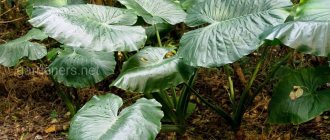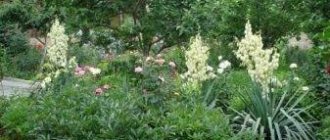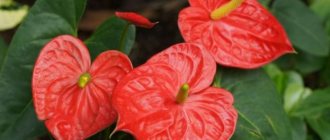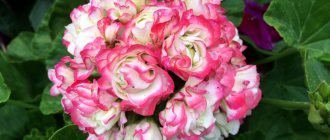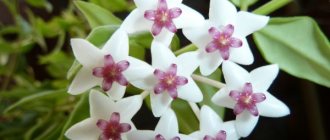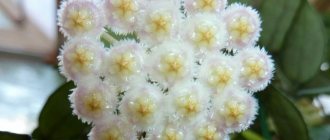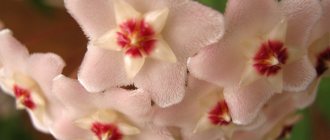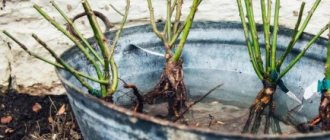A low indoor perennial plant, Latin name Spathiphellum Chopin, obtained by crossing Wallis spathiphyllum with other species. Its predecessor, Spathiphyllum Wallis, was brought by the scientist Wallis from Venezuela, and with the help of breeding work, a new species of Chopin was developed, which is particularly unpretentious to living conditions.
The second name of the plant is Chopin, derived from the pronounced Latin name. Another name for the plant is “female happiness” - for support and assistance in the lives of women and girls, as esotericists believe. For the plant to really help, it is advisable to receive this flower as a gift.
Description and photo
The plant is 35 centimeters in height, the leaves are rich green, glossy. They have an oval shape, entire edges, with clearly visible veins, because of which the leaf appears wavy, and a pointed end, 20-25 centimeters in length, and up to 5-6 centimeters in width, collected in a basal rosette. Planted on green petioles up to 18-20 centimeters, widening at the top and coming out almost from the ground. The flowers are light cream in color, collected in an inflorescence spadix, covered on the outside with a white, slightly elongated perianth.
Chopin differs from other types of spathiphyllums in the pleasant aroma of flowers - rich in the morning and decreasing in the evening.
Peculiarities
Spathiphyllum "Chopin" (or "Chopin") was brought to Russia from Colombia about 200 years ago and quickly became popular among our compatriots. If you are also attracted to this plant, and you are thinking about purchasing and growing a similar flower at home, then first of all you need to study its botanical description.
Traditionally, the plant reaches a height of 30–40 centimeters, which is a fairly standard indicator for plants of this type.
The leaves of "Chopin" are quite long (up to 24 centimeters in length), they have pointed edges, a glossy shine and a rich green color. The leaf petioles are subject to frequent bending, so the leaves may bend downwards.
The flowers of the plant are painted white (less often cream) and reach a length of 5 centimeters. As the seeds ripen, the inflorescences become saturated with green color. The flowering period lasts several months from spring to autumn. The first flowering usually occurs 6 months after planting the spathiphyllum.
Owners of this plant also note the unusual aroma emanating from the plant, which is a bonus to the external beauty of “Chopina”.
A distinctive feature of the home ornamental plant is the fact that it completely lacks a stem.
Is the plant poisonous or not?
The plant contains poisonous juice that can cause irritation and burns of the mucous membrane of the mouth and esophagus, as well as poisoning, and if the owner has a tendency to allergies, then it can cause a severe allergic reaction.
It is recommended that all work on caring for, replanting, and pruning the plant be carried out wearing protective gloves and goggles.
Allergies can manifest themselves as:
- red spots;
- rashes in the form of small red pimples;
- itching and general swelling;
- runny nose;
- the most severe symptom is swelling of the larynx, known as angioedema.
To reduce the allergic reaction, you need to take detoxifying drugs like activated charcoal and take antihistamine tablets. But it is better to consult a doctor immediately .
Poisoning manifests itself:
- rapid breathing;
- rapid heartbeat;
- severe headache;
- slower reaction;
- sweating;
- general weakness.
To provide assistance to the victim, it is necessary to call a doctor, or hospitalize the patient in a nearby hospital .
If your pet is injured
Cats very often touch the soil in pots, and in winter they often gnaw leaves. It is worth paying attention to such symptoms as:
- lack of physical activity;
- your pet just lies there and doesn’t get up;
- he breathes quickly and hoarsely;
- the heart beats very quickly;
- a lot of saliva is produced.
You need to give the animal one tablet of activated carbon at the rate of one tablet per kilogram of weight and take the pet to the veterinarian.
Difficulties in growing
Incorrect lighting, fertilization and watering regimes can cause alarming symptoms and general weakening of the plant.
No flowering
Sometimes spathiphyllum does not bloom at all or sheds its leaves and buds. Possible reasons:
- lack of light;
- pot too big;
- there is no rest period;
- lack of minerals in the soil.
The leaves are turning pale
Leaves lose rich light due to lack of light.
The tips of the leaves dry out
If the tips of the spathiphyllum leaves turn black and dry, then the following care errors are likely:
- lack of fertilizers;
- too much and frequent watering;
- lack of humidity.
Important! When the plant withers from lack of moisture, the pot is immersed in a container of water, kept there until the bubbles stop rising, then the water is allowed to drain.
Brown spots on leaves
This also includes the problem of why the lower leaves fall off.
Possible reasons:
- sunburn;
- rotting due to stagnation of water in the soil;
- excess fertilizer.
If a plant is overfed, it should be immediately transplanted into fresh substrate.
Bloom
The plant blooms from the second year of life, from the end of March until the end of October inclusive. The flowers are small, collected in an inflorescence spadix, light cream in color, protected by a large perianth, white, sail-like. Blooms for 2-3 weeks.
After the flowers are pollinated and before the seeds begin to ripen, the perianth becomes green and remains that way for another couple of weeks. After pollination of the flower, a berry is formed, inside which a curved seed ripens.
How is it different from other varieties?
The main thing that distinguishes Spathiphyllum Picasso from most of its counterparts is the original color of the leaves, which is unique to this hybrid. In addition to the green segments, the leaves have white areas, which sometimes occupy more than half of the entire surface. Due to this, the plant looks very impressive and at the same time gentle.
Not only the leaves, but also the flowers can boast a variegated color: the cover around the cob is initially white, but gradually light green fragments appear on it.
Variegation is a rare property for spathiphyllums, which makes the Picasso hybrid especially valuable.
In addition, this variety is distinguished by its relatively small size in comparison with other varieties, the spreading nature of the bush and - which is no less valuable - its particular unpretentiousness.
Where to buy Chopin? What is the price?
You can purchase Chopin spathiphyllum at a flower shop or through an online store. The cost of a flower is determined by the age when the flower is planted - a seedling or an adult plant.
A flowering plant with a 15 centimeter pot will cost from 250 rubles or more , a small seedling in a 9 centimeter pot costs from 180 rubles. You can just buy a seedling, it costs less - from 50 rubles.
Reproduction
The reproduction of this type of spathiphyllum does not differ significantly from the reproduction of other species. It is done to obtain and breed new plants. Reproduction also has a positive effect on the rejuvenation of old Chopin. Reproduction by leaves with this flower is impossible; a leaf planted in water will simply rot. This type of plant is propagated by cuttings. Dividing a bush is a simple and popular method.
The adult root produces new small “babies” when spring comes, and with it the time of transplantation, these roots are carefully separated from the main root. Now both plants are ready for independent life. The cuttings are placed in moist sand soil and covered with a jar. When the roots appear, they are planted in pots.
Landing
In order to plant a plant correctly, you must select a pot; its size cannot be larger or smaller. The pot should be 3-4 centimeters larger than the spathiphyllum roots . Need to:
- Place expanded clay on the bottom and sprinkle with a little nutritious soil.
- Place the seedling in the pot and, holding it, fill it with soil to the edges of the pot.
- Lightly crush and water.
Soil for planting indoor flowers can be purchased at the store, or you can prepare it yourself. To do this, you need to mix sheet soil, turf, peat, and sand in equal parts.
Seeds
To plant a plant with seeds, you need to prepare a tray or container with a wall depth of no more than 3-4 centimeters. Step-by-step instructions for growing spathiphyllum from seeds :
- Pour the prepared soil into the prepared container, having previously calcined it.
- Scatter the seeds, or press the seeds into the ground by hand. Water everything, cover it with specially prepared transparent glass, and place it on the windowsill.
- Continue to water and sometimes ventilate, avoiding waterlogging and the appearance of mold fungi.
- After the emergence of seedlings, continue watering and airing until the sprouts are 3 centimeters in height.
- Plant the seedlings in small cups and continue watering.
- When the seedlings reach a height of 6 centimeters, transplant them into slightly larger cups.
- After 12 weeks, transplant into permanent pots and place in a permanent place.
- After 2 weeks, we begin fertilizing with complex fertilizers.
Transplant methods
The “Women’s Happiness” flower needs to be replanted for the first time immediately after purchase, then as it matures and the root system grows. The procedure is performed as follows:
- Young plants need to be moved to a new pot every year. When they turn 4 or more years old - once every 2-3 years. The root system of a flower is thin and fragile, especially in young plants, so during replanting you need to carefully dig up the flower so as not to damage the thin roots.
- When replanting, select a pot that is at least 3 cm larger. But it should not be too large, otherwise the soil will begin to sour and the water will stagnate.
- Carefully dig up the plant, clasp it at the base with your hands and remove it from the pot along with the remaining soil on the roots. Soil can be removed from plants that are too old. Leave the soil on the young ones and transfer them with it to a new container.
- The bottom of the pot must have holes for drainage. The best containers are made of ceramics; you can use plastic pots.
- Organize the drainage layer from pebbles, fragments of brick or old ceramic pots, and perlite. The thickness of the layer at the bottom of the pot is at least 2 cm. Sprinkle it with soil on top to about 2/3 of the height.
- Place a plant in the center of this mound, cover it with fresh soil, and compact it so that there are no voids left.
Immediately after planting or transplanting, watering is not recommended for two weeks. The plant needs this time to adapt. Protect it from drafts and temperature changes.
Caring for a plant at home
Spathiphyllum Chopin is a specially bred hybrid that is easy to care for.
- Temperature . As an inhabitant of tropical countries, spathiphyllum loves warmth and its comfortable temperature will be +18-24 °C. The critical temperature at which a flower can die is +10 ºС.
- Lighting . The plant tolerates shade and partial shade well, but at the same time the decorative properties of the plant are lost, the green color becomes faded or disappears altogether. Direct sunlight burns the leaves. It is better to place the plant on the east or west side.
- Watering and humidity mode . It is necessary to water abundantly so that the soil does not become dry. Approximately once every two or three days in the summer, and once a week in the winter. With a lack of water, as well as with an excess, yellow and brown spots appear on the leaves, and the edges of the leaves dry out. For irrigation, use soft, room temperature water, standing for 5-6 hours. It is advisable to wash the leaves with a sponge or spray them at least once every 10 days.
- Fertilizer . Feed with complex fertilizers with a break of two weeks throughout the winter period. A month before flowering begins, it is necessary to switch to potassium-phosphorus fertilizers, which are necessary for normal budding and flowering.
- What to do if it doesn't bloom ? If spathiphyllum Chopin does not bloom at all, first of all you should pay attention to the size of the pot, then to the amount of fertilizer, it may not be enough, and to the temperature in the room.
- Trimming . Dry leaves and old flower stalks are regularly trimmed. This must be done carefully so that the plant juice does not get on your hands.
- Transplant . To replant an adult plant, you need to again pay attention to the size of the pot.
- Care during flowering . During the flowering period, abundant watering is required, you should pay attention to the leaves. Black spots appear on them if the roots rot - this is the most common disease of spathiphyllums. There is no need to feed the plant during flowering.
- Reproduction . Spathiphyllum Chopin can be propagated by shoots and seeds.
What to do if it doesn't bloom?
Spathiphyllum Chopin blooms once a year, but it happens that flowering does not occur. This is due to various factors. To speed up the flowering process, create stress for the plant, change the living conditions. A positive result is obtained by lowering the temperature to +16 °C and reducing the amount and frequency of watering. There is no need to reduce lighting. The soil in the pot is dried regularly.
To stimulate flowering, you can try using drugs intended for this purpose. And by caring for the flower correctly and with love, it will begin to delight you with beautiful elegant blooms.
Spathiphyllum cannofolia
The Spathiphyllum Cannifolium plant has the densest and narrowest leaves of all related species, up to 40 cm long.
The front side of the bract is white, and the “back side” has a pronounced green tint. The length of the spathe of this large, attractive plant is 10–22 cm. This is twice the size of the white or yellowish cob. The peculiarities of the species are that the inflorescences have a pronounced aroma, and the cob itself is not tuberous, but smooth. In nature, plants of this species can be found in the tropical forests of South America, as well as in Trinidad.
Interesting video
We invite you to watch a video about the plant Spathiphyllum Chopin:
If you find an error, please select a piece of text and press Ctrl+Enter.
Spathiphyllum “Chopin” (the second name of this plant is “Chopin”) is an ornamental plant that can grow and develop at home. Spathiphyllum of this species has a rather attractive appearance, so it is popular among lovers of house plants, housewives and breeders.
What are the characteristic features of this plant? What conditions must be created for its cultivation? How to properly care for Chopin? How to replant and propagate a flower? Our article will answer these questions in detail.
How to choose?
On the shelves of flower shops, all the flowers look healthy and attract attention. However, external appearances can be deceiving; you should not take the first flower pot you come across.
Let's figure out what you should pay attention to
- Leaves. Leaf blades of a healthy crop do not have mechanical or other damage or defects, and are evenly colored green, with the exception of variegated varieties. There are no spots of any color, the leaf is dense, juicy, glossy.
- Shoots and inflorescences. Petioles, peduncles, cobs, perianths are not damaged. The shoots are dense to the touch. Cob covers without signs of wilting or dry tips.
- The soil. Be sure to inspect the ground in which the plant is located. You can slightly pull the crop up from the temporary pot to inspect the condition of the root system and how filled the earthen ball is with roots. The soil should not emit unpleasant odors or be flooded. The surface layers of the soil should not contain traces of mold, insect activity - cobwebs, “fluffy” deposits.
Beautiful examples
In residential premises, culture acts as a decorative item. Plants are planted in snow-white pots of various geometric shapes, emphasizing the color of the bracts and highlighting the rich tone of the foliage.
Flowers can be planted in groups in wide planting containers. This method is used to visually divide space into zones in residential and office premises, as a decoration for various massive interior items: dining tables, chests of drawers, and so on.
In landscape design, spathiphyllums act as a border or flower arrangement. They require high-quality soil drainage, its composition and care as the plant grows.
An overview of the types of spathiphyllum is presented in the following video.
Spathiphyllum red
Sometimes you can hear that nurseries offer spathiphyllums with red or pink bracts. However, before you succumb to a tempting offer and rush to purchase a rare flower, it is worth understanding the classification.
A white bedspread can only become colored under the influence of chemicals artificially introduced from the peduncle. Under natural conditions, the bract can only turn green. And yet there are plants that are closely related to spathiphyllum and have colored perianth. These are anthuriums well known to gardeners. Thanks to breeders, depending on the variety, they are able to please the owner with scarlet, burgundy, pink and almost white covers of inflorescences.
Spathiphyllum and anthurium have many common morphological features. Therefore, in the West, the common name is applied to plants - peace lily. By the way, if spathiphyllum is considered a talisman of female happiness, then anthurium is the embodiment of male well-being and strength. Although we have not yet managed to obtain red spathiphyllum, these plants can become a good pair and complement each other on the windowsill.
Prevention
In order to prevent the occurrence of many diseases in spathiphyllum Alan, you need to properly organize its care, and also follow the following rules:
- Transplantation should be carried out into a freshly created substrate.
- When preparing the soil with your own hands, it must be calcined or frozen.
- The container must be treated with chemicals.
- Inspect the plant regularly. After all, timely detection of the disease becomes the key to successful treatment.
Popular articles White truffle mushroom - where and when it grows, search features, cultivation
Thus, growing “female happiness” is not difficult
It is enough to carry out proper care and take precautions
